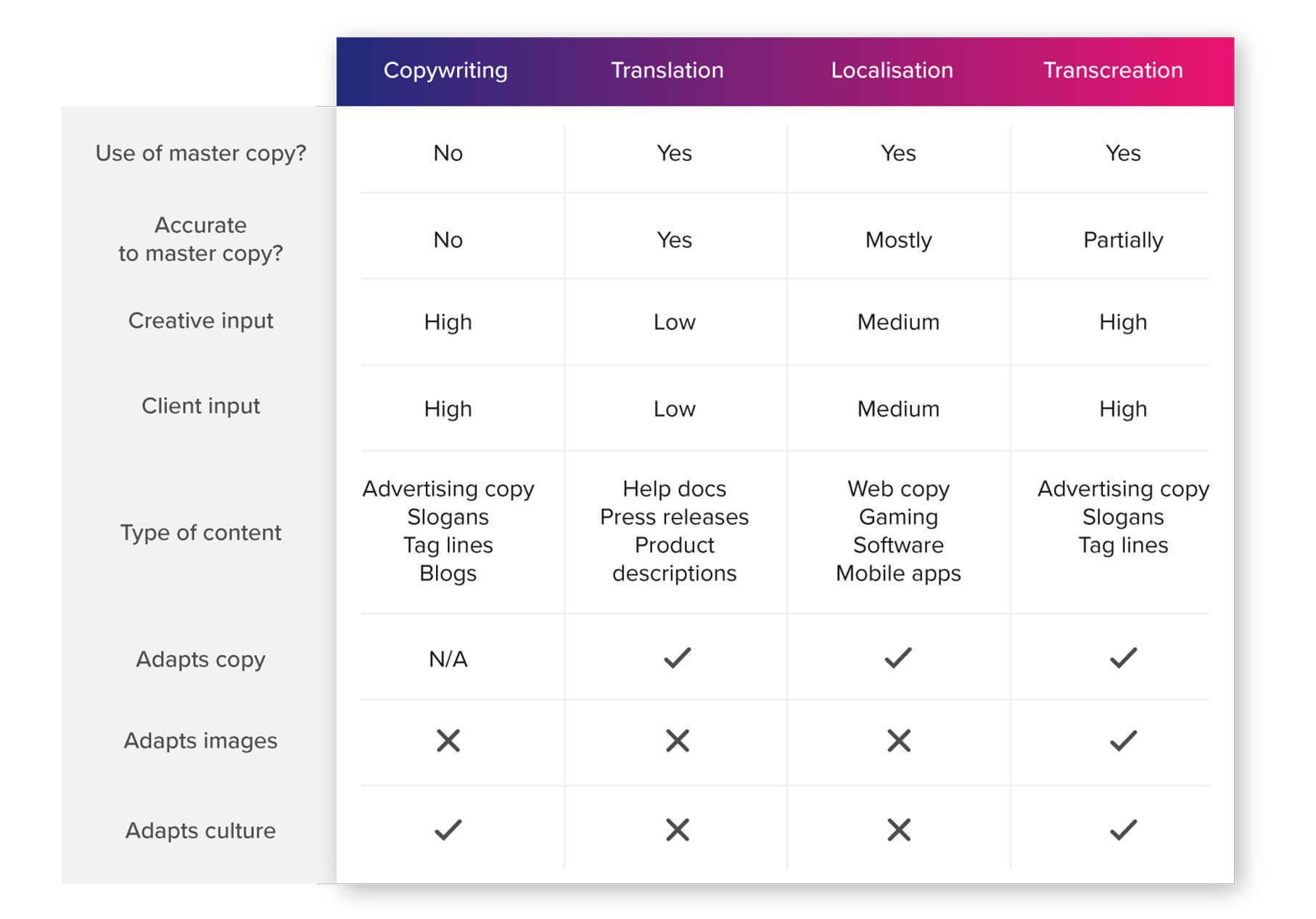
Translation is the act of translating content, such as words, phrases, sentences, articles, poems and so on, from one language to another. Translating copy employs native and bilingual translators to transform the message and, still, keep the meaning of the original content from the source language. Translators should only translate texts into their native language, even though they may be fluent in another language. This guarantees that the linguistic subtleties of the language are taken into account. Additionally, translators should specialise in specific fields, such as accounting, design or law. This allows them to more effectively translate content from specific industries that other translators may find difficult.
Transcreation, on the other hand, involves both creative writing and translation work to include the culture and nuances of a region, while communicating with audiences in their native languages. Translation often uses copy editors from respective countries that specialise in creative copywriting in order to portray the “spirit” of the message.
”Marketers must keep many elements in mind when deciding which of these services is most effective for the success of their global campaigns – including the type of content, objective and target audience.”
Transcreation process
- Agency receives a brief and a final master copy from the client.
- Debrief takes place to align agency-client expectations and ways of working.
- Agency establishes a working process, provides timings and costs.
- Transcreation by in-market advertising copywriters begins.
- Quality check by other in-market advertising copywriters is conducted.
- Clients’ revisions take place and any amendments are incorporated.
- Final version of the copy is approved by native speaking proofreaders.
- Final copy is delivered and / or implemented into the artwork.
- Final artwork is again QC’ed by a native speaking project manager.
Translation process
- Agency receives a brief and source material.
- Debrief takes place to align agency-client expectations and ways of working.
- Agency reviews the total word count and complexity of the language.
- Agency provides a cost estimate and timings.
- Translation by a native speaking translator (without cultural adaptation) begins.
- Quality check by a native speaking proofreader is conducted.
- Clients’ revisions take place and any amendments are incorporated.
- Final version of the copy is approved by a native speaking proofreader.
- Final copy is delivered in the requested format and / or implemented into the artwork.
- Final artwork is again QC’ed by a native speaking project manager.
Translation vs Transcreation
Good transcreation is made possible by high-quality translation. The text is not translated verbatim, but focuses on the target audience’s reaction to the message. Therefore, it is important that the “spirit” or concept of the original text in the source language is completely re-established. So, the transcreator no longer has to “stay true” to the exact language of the original text.

Here’s some differences between transcreation and translation services:
- A transcreator must excel at, both, translating and creative writing.
- Transcreation content is usually in short form, such as logos, posters or commercial scripts.
- Translation rates are normally dependent upon word count, whereas transcreation services usually billed by the hour.
- Marketers supplying the original copy must provide the original concept, the objectives of the message and how the audience should react to the message in the best-case scenario.
So, when and how should a marketer choose to use translation?
When to use standard translation: Translation is the most cost-effective service because the translator does not have to use creativity in the same way transcreation experts must. If a region’s culture does not in any way affect the content and the brand language isn’t a key element, standard translation should suffice. For materials, such as catalogues, training and user manuals or other copy that should strictly depict the original text, standard translation is usually sufficient.
When not to use standard translation: Standard translation isn’t the best option when distributing content over various regions because it does not take cultural nuances into account – what may resonate in one specific region may be alien to another. What may be catchy in English may not make sense at all in German. In fact, a literal translation of a phrase in English, without acknowledging cultural differences, may very well unintentionally offend your target audience.
Advertisers often use literary techniques, such as wordplay, double entendre, puns or humour. Unsurprisingly, these sorts of phrases can be quite difficult for translators to translate into other languages. For example, “shoot” in English can be used in regards to film, golf or weapons. Therefore, a brand that makes golf equipment may use the double entendre, “nice shot.” However, the phrase may not mean a thing in another language; they’re just merely two words. Effective transcreation recreates the original message and the impact that it has on its audience, even if it does not necessarily use the same words.
In terms of pricing, transcreation rates charge at least quadruple per word than what a local translation service provider might charge. A common practice is to budget transcreation costs by the hour and effort needed to provide effective services.
FedEx had a slogan of just four words, “The World On Time.” Translating this simple phrase at a per-word rate would be less than a dollar. However, hundreds of thousands of dollars were invested in creating such a powerful slogan. The effort it takes to transcreate a phrase such as this cannot charge per word. Even though these services seem small in comparison to long-form text, such as technical documents, more attention is needed to successfully achieve a good transcreation.
Manuals that are used occasionally may contain some grammatical errors without too much of an impact, whereas pre-sales materials are much different. Research shows that incorrect language in pre-sales campaigns can affect the overall results, as most consumers are hard on text they find offputting. If the message sounds off to the consumer, they will have a negative outlook on the brand during the entire buying process. That’s why it is important for transcreation to be as fluid in target languages as it is in the source language, engaging audiences to interact with or buy products. Therefore, it is appropriate that transcreation pricing be measured in regards to hours and effort, as opposed to per-word rates.
Transcreation vs. marketing translation
Transcreation and marketing translation generally provide the same services. However, the difference is in the fact that, occasionally, the translator is not supplied with the original content. The transcreator, instead, is given a transcreation brief to be inspired by which is tailored for a specific audience.
Transcreation and marketing translation usually offer the same services, including rewriting brand materials and sales collateral for local, target audiences, while redesigning them to resonate in the respective regions. Brands utilise transcreation and marketing translation services to expand in countries where the original communications in the source language or word-for-word translations are meaningless to target consumers.
For example, Nike changed “Just do it” to “Date to Become” for the Chinese market. Even though many markets around the world reacted positively to “Just do it,” a standard translation for the Chinese market would not have portrayed the brand’s core message.

Marketers must keep many elements in mind when deciding which of these services is most effective for the success of their global campaigns – including the type of content, objective and target audience. Employing a combination of the services might be the right answer. For example, marketers may use transcreation for their slogan, copywriting for their client’s blog and translation for press releases.
Coca-cola case study
Even before the word truly existed, Coca-Cola used transcreation to its fullest by creating campaigns that resonated around the world. As an industry leader in global marketing, Coca-Cola created a simple brand message – happiness. In 1928, Coca-Cola communicated its message in China with a symbol in Mandarin (Kokou-Kolay), which means “to permit the mouth to be able to rejoice”. The literal translation, in this case, would be to “bite the wax tadpole”. Coca-Cola’s 2009 tagline, “Open Happiness” was a universal translation for the United State’s “The Coke Side of Life” message. The company’s recent “Taste the Feeling” campaign is heavily reliant on local media to reinforce the brand’s message by creating stories that are culturally relevant.





